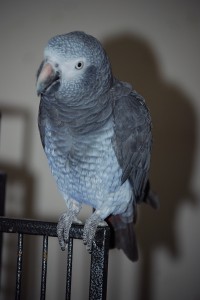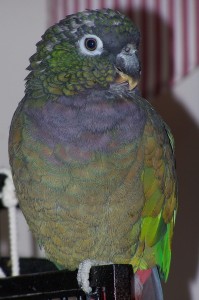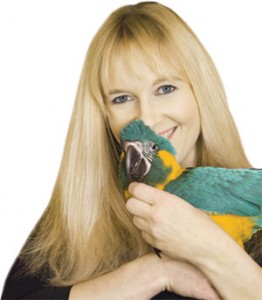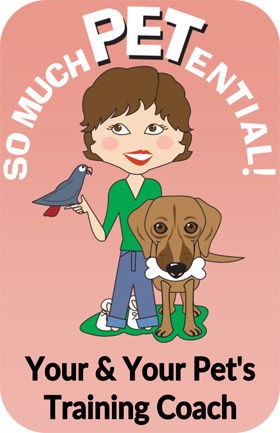Pets
Have A Jealous Or Stubborn Dog? Why I Can’t Help.
NOTE: I have a new pet behavior blog located at http://www.SoMuchPETential.com/blog. Thanks!
It happens SO often. When you ask pet owners about problems they are having with their pets, it boils down to their pet being dominant, jealous, dumb, stubborn, territorial, vicious, a pest, or just plain BAD.
Well, here’s the thing. When you tell me your dog is jealous, stubborn, or unmotivated I have absolutely no idea what it is  that your dog is actually ‘doing’ that causes you to see him as jealous, stubborn or unmotivated. When you tell me your bird is dominant or vicious, a number of different pictures go through my head – none of which could describe how your bird is behaving.
that your dog is actually ‘doing’ that causes you to see him as jealous, stubborn or unmotivated. When you tell me your bird is dominant or vicious, a number of different pictures go through my head – none of which could describe how your bird is behaving.
Descriptor words like jealous or stubborn really serve no value when it comes to behavior modification. They are adjectives that are better known as constructs in the science world.
In a recent course I took from Susan Friedman, Ph.D., she described it this way: “A construct is a kind of label that goes beyond a description of observed behaviors into the realm of hypothetical explanations for why an animal does what it does. While a construct may give a summary for a pattern of behavior, it serves as no help when it comes to developing a plan for changing the behavior with the most positive and least intrusive strategies.”
Susan went on to teach us that “constructs are nothing more than concepts that can’t be tested; constructs provide us with excuses to blame or worse get rid of the animal; constructs increase the use of ineffective training strategies and strategies based on punishment; constructs give us a false understanding of the problem when we’ve only given it a name; constructs foster self-fulfilling prophecies because you get what you expect; and constructs end our search for actual causes we can do something about.”
Just the other day someone was complaining to me about problems she was having with her dog who became ‘jealous’ when she got a boyfriend. “Baxter is a good dog. He’ll grow out of it,” was her response when I asked more questions.
Hmm. How about, instead of labeling her dog’s behaviors with constructs, she asks herself the following questions instead: What does this label ‘look’ like in terms of actual, observable behavior? Under what conditions does the behavior occur? What is the immediate outcome the behavior produces for my dog?
The answers will help her determine clearly defined behavior-change targets, antecedent predictors that set the behavior in motion, and what consequences maintain or strengthen the behavior. For example, instead of saying, “My dog is jealous,”, she could say, “When I sit on the couch with my boyfriend (antecedent), Baxter paws and bumps me (behavior) until I give her attention (consequence).”
Now I can see clearly what the behavior is that my friend wants to modify with an alternative behavior she wants to see more of instead. Now she can create a plan to make changes in the environment to set Baxter up for success such as teaching Baxter a behavior that is put on cue, and that is given when she sits on the couch with company.
And in the end, everyone succeeds.
Using Systematic Desensitization To Curb Pet Aggression
NOTE: I have a new pet behavior blog located at http://www.SoMuchPETential.com/blog. Thanks!
This is an inside look at how I used behavior analysis and systematic desensitization to work through a very serious behavior issue in my house. NOTE: this article was written for Hyde Park Living over a year ago.
It all began about six week s ago. Until then, my birds always had free access to their environment with their cage doors open whenever I’ve been at home. For the most part they’ve stayed on their own cages either napping or keeping busy with things I’ve given them; or Barnaby would fly onto his play cage in the other room.
s ago. Until then, my birds always had free access to their environment with their cage doors open whenever I’ve been at home. For the most part they’ve stayed on their own cages either napping or keeping busy with things I’ve given them; or Barnaby would fly onto his play cage in the other room.
And that is why, when I came upstairs to hear ‘Mommy here!’ coming from down the hall I initially thought it was just another day…until I saw Dreyfuss atop Barnaby’s cage. Dreyfuss chased Barnaby off his cage and that one bad decision set everything in motion.
Just the sight of Dreyfuss transformed Barnaby, my gentle teddy bear, into pure rage. (aggression not to me, only directed toward Dreyfuss) Barnaby flew at her like a hawk would fly after prey. I’ve never seen him behave like that. That day I kept both birds separated, and then ‘I’ made a bad decision. Barnaby really wanted back into his room and I thought I could allow him open cage time if Dreyfuss was in her cage with the door closed. Sadly, in a split second, Dreyfuss climbed the bars of her cage and Barnaby dove in, tearing Dreyfuss’s toe open.
OK, there was no more room for bad decisions. I had to come up with a game plan fast. Knowing that ‘positive practice makes perfect’ when it comes to any behavior, my short- term goal had to be preventing any situations that would create opportunities for Barnaby’s flying at Dreyfuss behavior. Every moment of every day that passes without Barnaby flying at Dreyfuss is a practice-free victory.
Remember those ABCs of behavior I’ve been talking about? Well, in this case the antecedents that predict Barnaby’s flying behavior included Dreyfuss being outside of her cage – whether sitting on her door, on top of her cage, or on my hand when Barnaby was within close proximity of less than six feet apart. Actually, when I analyzed it closely, there is a chain of ABCs. Those antecedents predicted Barnaby’s feathers to stand erect, his body to become taught, and his eyes to be pinned while being transfixed on Dreyfuss.
The ABC formula for this would be: (background scenario is that the birds are within six or seven feet from each other and usually in their own room) 1. Antecedent – Dreyfuss is outside her cage; Behavior – Barnaby’s feathers stand erect, his body becomes taught, and his eyes pin while being transfixed on Dreyfuss; Consequence – Dreyfuss stays where she is at. 2.) Antecedent – Dreyfuss stays where she is at; Behavior – Barnaby flies at her; Consequence – Dreyfuss gets knocked to the ground, injured or fights back.
As you can see, Barnaby clearly exhibited non aggressive body language that did not achieve a desired consequence, which escalated things to the aggressive flying behavior. By looking at the behavior in the context of its environment, the key to success here was to interrupt that chain. I had to work to 1) reduce or prevent circumstances as much as possible that would cause Barnaby to exhibit that body language to begin with and 2) if Barnaby did show any of that body language, I needed to empower him by allowing him to have a positive consequence from that nonaggressive behavior BEFORE it escalated.
The key to all of this was my being consistently and extremely aware at ALL times of Barnaby’s body language.
In the beginning when tension was at the extreme (when just the sight of Dreyfuss would set things in motion), I kept the two birds either in their cages or as far apart as they needed to be in order for Barnaby to be relaxed. And I never missed an opportunity to reinforce calm behavior with attention and/or food. (If they were out of their cages, one was in the tv room.)
Slowly I was able to carry Barnaby closer to Dreyfuss all the while going only at a pace that Barnaby’s body language told me he was comfortable with. As I walked with him on my arm, I continued to divert his attention with a lot of my attention. The second that I saw any sign of tensing up in his body, that was my cue to back up and start again. Scientifically this is called systematic desensitization, when you gradually expose an animal to a feared stimulus in small, incremental steps, never crossing the threshold into tense body language.
After some days when Barnaby was showing calm body language (not fixating on Dreyfuss, feathers down) while in the same room as Dreyfuss – in another area of the house – it was time to start working with them in their own room where the flying behavior is most likely to occur. Always in prevention mode, I let Barnaby out of his cage first and then gave him a few seeds before taking a step toward Dreyfuss’ door. I never took my eyes off Barnaby. If I noticed even one of those precursor behaviors just starting, I backed away from Dreyfuss’ cage. Again, slowly we got to where I opened her door and got her out. Then, as soon as she was out, I held her at arm’s length while giving Barnaby more attention for showing calm body language. Next, when we got to where Barnaby would step up on my other arm while I was holding Dreyfuss, I ignored her while talking to Barnaby.
Over time and positive repetitions, because I used only positive reinforcement while allowing Barnaby the power to make his own decisions, he no longer pins his eyes or gets taught when I let Dreyfuss out of her cage or pick her up and I can walk out of their room for short periods of time, while still in range.
I’m not sure if there will ever come a day when I can leave their cage doors open for hours at a time again (Barnaby does still need his exercise flying laps after all), but it sure is nice having peace again in our house.
Why Do Pet Birds Bite?
(this is one of my past columns from Hyde Park Living)
Okay enough already. I have seen and heard enough of people telling me about mean, aggressive, grouchy, or dominant birds that bite.
I have heard too many anecdotes for ‘curing’ or ‘fixing’ the problem that are all about ‘fixing’ the bird by being the boss of it. About the only thing all these stories seem to have in common is that the fault always seems to rest on the bird. To that, I will emphatically say – wrong!
One such answer involved clipping wings so that the bird can’t escape. Ironically, letting my birds grow in all their flight feathers has given them so much more confidence because they CAN escape. It has also made me much more aware of how important it is for me to ensure the reinforcing value of their being somewhere because if I don’t, well, they can easily decide to be somewhere else.
In the wild, although vicious attacks occur when a nest site is involved, rarely does competition or conflict escalate into physical violence. Instead they vocalize and/or use body language (such as flapping their wings, posturing, fluffing feathers) until ultimately one will fly or move away.
Why then do birds bite humans? Well, for one humans who get bit generally aren’t very good listeners when it comes to watching their bird’s body language. They don’t allow their bird to nonagressively warn them to back off. Instead they push the limit and they have their body parts where they shouldn’t be (that’d be too close to a bird’s beak when the bird doesn’t want you there). They teach their birds that nonaggressive body language just doesn’t work in communicating to aggressive, grouchy or dominant humans.
Remember – behavior is a function of its environment. It happens because it serves the animal a purpose. If a behavior reoccurs, it is because it is being reinforced. And, every time it reoccurs is practice until perfect.
If your bird is on his cage with his tail flailed out and his pupils dilated and you force your hand in his belly to make him step up, I can predict what will happen. You’ll get nailed, you’ll back off (probably yell a thing or two), and your bird will remain where he wants to be. That one occurrence has taught your bird that the only way to get you to leave him alone is to bite you because dilating his pupils, flailing his tail or standing erect is of no use. The funny thing about this is that, when you do give your bird the power to choose whether or not to be with you (that is, assuming you are worthy of being with), he will be more likely to choose to be with you.
I can tell you the reason that I talk about Barnaby as a bird who doesn’t have an aggressive bone in his little body is because his entire life he has been with people who have allowed him to speak with his body language. He has never needed to resort to biting to make a human back off and as a result, he chooses to want to be around humans more. No matter what I do I always watch him to ‘tell’ me he wants me to do what I’m doing (either by his lifting his foot for a step up, running toward me, leaning into me, etc.).
Instead of keeping strangers from him I encourage them to interact with him; however, I always watch his body language to ensure he wants their interaction. If I notice any body language that says ‘stop, you’re too close’, I make sure those people back up.
Of course there may be times when I have to tilt the scale in my favor with his favorite food treats – like when I need him to go to sleep and he wants to stay up and watch tv instead.
Please, stop blaming your bird for just doing what works for him. Instead learn to pay close attention to his body language and what is going on in his environment. Learn to remove the need for your bird to bite in the first place.
Dog Training – Teaching Your Dog ‘Drop’
NOTE: I have a new pet behavior blog located at http://www.SoMuchPETential.com/blog. Thanks!
‘Drop it’ is such an important behavior to teach your dog for so many reasons. Below are two strategies for teaching it by trainers who use positive reinforcement. Both approaches will get you to the end result of your dog dropping something.
Barbara Heidenrich
 I know Barbara through the International Association of Avian Trainers and Educators (IAATE), have been fortunate to have taken several of her workshops, and have written several articles for her Good Bird Magazine in the past. Barbara is an internationally renowned trainer whose experience inludes consulting in zoos and other animal related facilities around the globe. She has been a part of the development and production of more than 15 different free flight education programs and has worked with 20 different animal facilities. You can learn more about her at her website.
I know Barbara through the International Association of Avian Trainers and Educators (IAATE), have been fortunate to have taken several of her workshops, and have written several articles for her Good Bird Magazine in the past. Barbara is an internationally renowned trainer whose experience inludes consulting in zoos and other animal related facilities around the globe. She has been a part of the development and production of more than 15 different free flight education programs and has worked with 20 different animal facilities. You can learn more about her at her website.
Below is an excerpt from one of her past Good Bird Magazine issues:
Puppies are notorious for chewing up all sorts of contraband. Despite my best efforts to keep all items I did not want chewed up from the floor, I knew there would be moments when my favorite shoes might end up in my puppy’s mouth. I decided to teach a strong ‘drop’ behavior.
To do this, I armed myself with Waylon’s absolute favorite treats hidden in my fist. I offered Waylon an acceptable chew toy such as a stuffed animal. As he was chewing, I place my closed fist full of treats next to the toy, when he would stop chewing and smell my closed fist, I bridged (said the word ‘good’) and opened my fist so that he could get a treat. This was repeated several times, until the presentation of my fist would quickly cause him to drop what was in his mouth. I then added a verbal cue as well. I chose the oh, so clever, word ‘drop’.
My next step was to raise the bar a bit. I offered Waylon something he enjoys more than a stuffed toy, his squeaky ball. This was followed by even more enticing items, including a bone. Every time Waylon dropped the item he received a treat, or in some cases I simply offered back the item he had dropped, or another fun chewable item. When the day came when he found a shoe, I walked up to Waylon as I would under any circumstances. This meant no chasing, yelling or shrieks that my shoe was in his mouth. I calmly gave him the drop cue and the shoe left his mouth unscathed and hit the floor. I also did not have a treat in my hand, which was not a problem. My goal had always been that the treat would be phased out from being hidden in the hand. This time I gave him lots of praise and attention, which worked fine as a reinforcer. Now I regularly reinforce with all sorts of things…a treat, giving back the item he dropped, attention, another acceptable chew toy, etc. I so enjoy that he will drop even the smallest item when cued. And he does it eagerly knowing something else he enjoys is sure to follow.
Domesticated Manners
Below is a video by London, England based Domesticated Manners.
Note the video has a disclaimer: I would suggest that you do not use this with dogs who are “protective” over their food or other resources but work with a qualified behaviourist / trainer who may use a similar exercise if they see it to be beneficial and/or appropriate in your particular case.
Dog Training – Counter Conditioning To Overcome Fear
NOTE: I have a new pet behavior blog located at http://www.SoMuchPETential.com/blog. Thanks!
It was the Fourth of July and everyone likes a good fireworks show on the Fourth of July, right? Wrong!
Not Sam, my parents’ dearly beloved four legged companion who loves playing outside ready to greet every passerby with a tail wag. Sam has even learned to ask to go out by ringing a bell or running to find my mom or dad, nudging them and running toward the door. It happens pretty often…but stopped briefly after my parents’ neighbors thought it be fun to have their own fireworks  show on the holiday. At least it stopped at nightfall.
show on the holiday. At least it stopped at nightfall.
Suddenly being outside in the dark became a trigger for panic (rapid heart rate, tense muscles, running away). No matter what my dad tried, he couldn’t get Sam out the door willingly as soon as darkness descended. And, if he could get Sam outside by pulling Sam on a leash, the little guy would run charging back to the door. By day two, my parents let Sam stay in at night (he’s young and luckily can hold things until morning) until I could come over and work with him.
What did I do? I put my education to the test by using the most positive, least intrusive strategies I know to re-teach Sam that being outside after dark can be pretty darned fun. And in one night, that’s what he learned.
I used what is called systematic desensitization, a process of gradually exposing Sam to the fear-eliciting stimulus (outside darkness) WITHOUT unexpected loud noise, in small, incremental steps. The criteria for advancing to the next step was watching his calm behavior and only moving forward at a pace that did not elicit even the mildest of his fear responses. The beauty of systematic desensitization is that Sam was always in total control. His body language dictated whether we moved forward or stepped backward. And I don’t know about you but I like knowing I have the power to control my situation.
Here’s what I did. Starting far enough from the door where he was calm with his tail wagging, I gave him a treat, petted him and was silly with him. We slowly moved toward the door. If I noticed any sign of escape behavior, we backed up to where he was comfortable again. Then we started over. In the first session, we got to within about five feet from the door. We stopped and came back to it a half hour later.
By the next session Sam stood at my side as I touched the door, then opened it slightly without his showing any sign of tensed muscles or looking like he was going to run away. Fifteen minutes later we tried again and this time he touched his front feet outside the door before he backed up. That was time to stop for a half hour and start again. The next time we started with him at the door. He walked all the way through the doorway and I held it open so that he knew he could run the other way if he chose to. The choice was always within his power of his own body language. However, once he was outside, I raised the bar by grabbing a squeaky toy.
Suddenly all he could think about was playing. We got down the steps and I took off running. He charged after me and the thought of running to the door was furthest in his mind.
Sam had just re associated being outside in the dark with play because he had the power to decide when ‘he’ was ready to move to the next step and because I paired being outside with some of his favorite activities. That’d be eating, playing and getting attention. In scientific terms, that re association is counter counditioning a fear eliciting stimulus into a feel-good eliciting stimulus. Systematic desensitization on steroids my teacher likes to say. In other words, I drained darkness as an elicitor of rapid heart rate, tense muscles and running away and helped counter condition darkness into a predictor of good things for Sam.
And hey, I’m all for good things!















